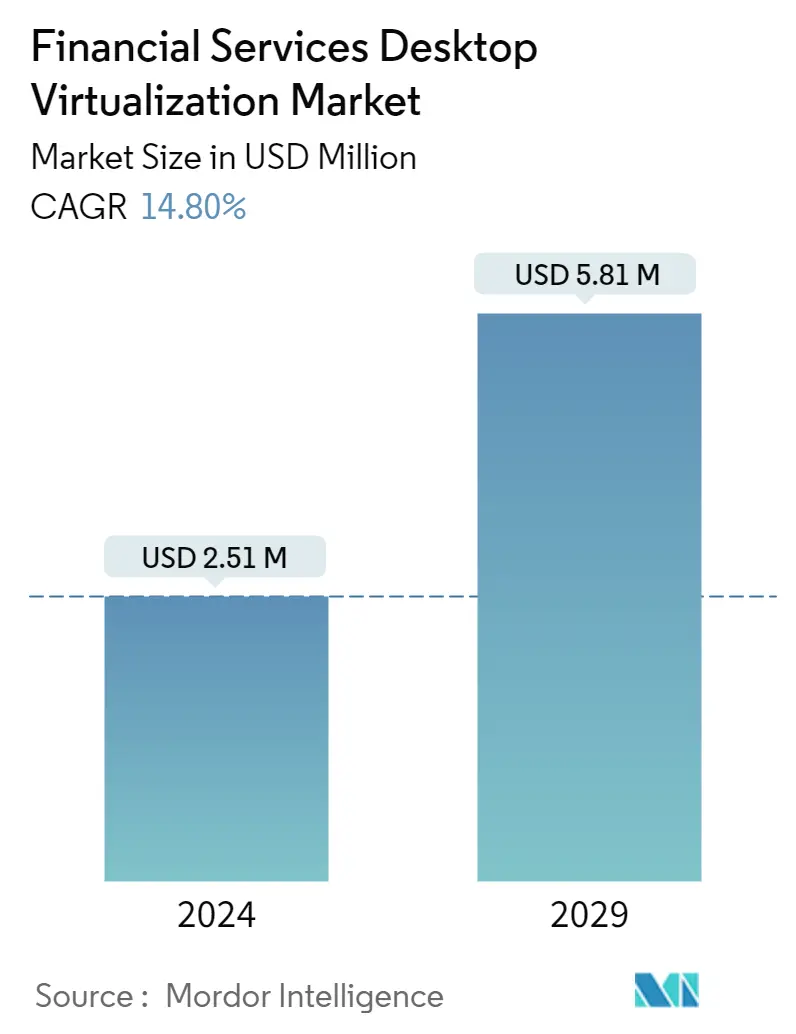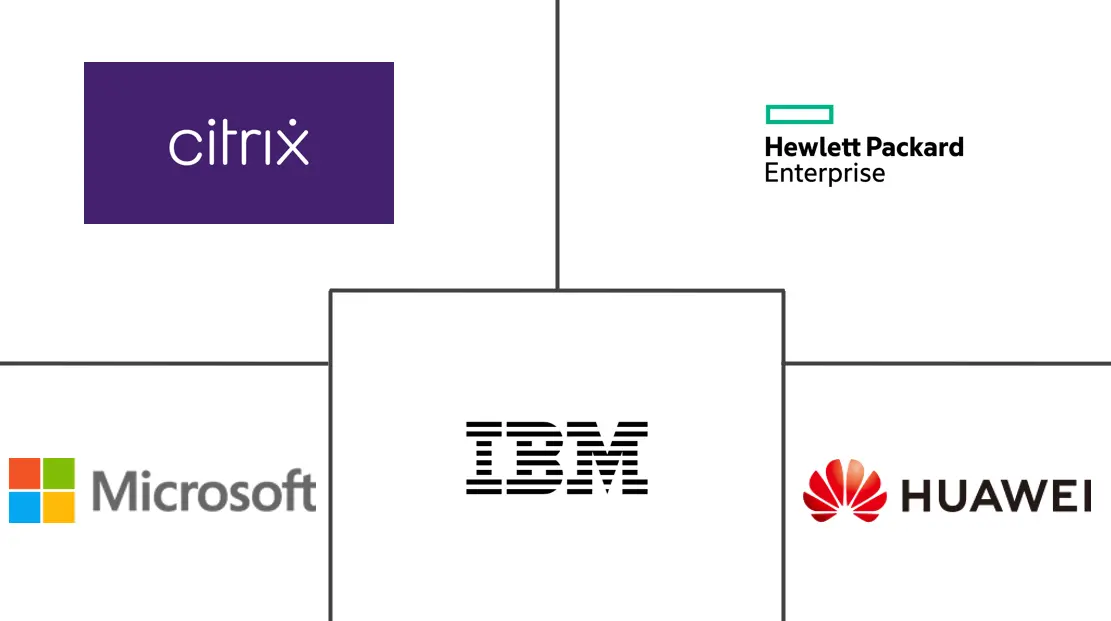Market Size of Financial Services Desktop Virtualization Industry

| Study Period | 2019 - 2029 |
| Market Size (2024) | USD 2.51 Million |
| Market Size (2029) | USD 5.81 Million |
| CAGR (2024 - 2029) | 14.80 % |
| Fastest Growing Market | Asia Pacific |
| Largest Market | North America |
Major Players
*Disclaimer: Major Players sorted in no particular order |
Financial Services Desktop Virtualization Market Analysis
The Financial Services Desktop Virtualization Market size is estimated at USD 2.51 million in 2024, and is expected to reach USD 5.81 million by 2029, growing at a CAGR of 14.80% during the forecast period (2024-2029).
Enterprises are concentrating on working remotely to make their employees more effective and productive. Moreover, remote working and cloud processing could lower the cost of IT equipment. Clouds have evolved as an infrastructure, allowing for rapidly distributing processing resources as a service in a dynamically scalable and virtualized environment. The use of desktop virtualization is driven by higher cloud uptake rates and corporate preferences for implementing computers on the cloud.
- Financial organizations frequently have numerous user categories or personas. Each user identity requires a distinct computer desktop image within the organization. These characters include front-office and branch employees such as tellers, customer support reps, and knowledge workers.
- So, for many financial organizations, designing a high-performance, scalable, and cost-effective VDI infrastructure that can support these multiple FSI personas, as well as meet seasonal demand spikes, provide disaster recovery (DR), and respond quickly to unexpected regional and global events or disasters, is a real challenge.
- IT teams find that the design, deployment, configuration, and management of professional graphics VDI platforms for applications that have previously run on physical workstations is becoming increasingly difficult in view of changing workforce dynamics, rising demand for virtual infrastructures as well as a variety of user types within the FSI sector.
- Different organizations may have vastly different requirements in terms of the type of IT infrastructure that is best suited to their specific needs, which can range from hyper-converged infrastructure (HCI) to converged infrastructure (CI) to standard three-tier designs that can define and scale the compute and storage components on your own.
- Moreover, The rising adoption trends of desktop virtualization across various financial sectors drive market growth. Many banking organizations are moving away from the conventional PC path with the hard drive towards desktop virtualization. Financial institutions to make the transition frequently implement a Virtual Desktop Infrastructure (VDI). This server computing paradigm allows desktop virtualization and includes the hardware and software systems required to support the environment.
- Further, simplicity in management, measuring, and monitoring are a few factors driving desktop virtualization in financial services. Moreover, the enhanced data security benefits the firms in the increased adoption of virtualization. Virtual computers cannot be taken, abandoned, or physically compromised. A disconnected virtual desktop no longer appears at the distant site, closing the site's most vulnerable security gap: the computer itself.
- However, configuring and implementing desktop virtualization is challenging due to the numerous complexities and interoperability problems. Before adopting desktop virtualization solutions, it is essential to analyze the infrastructure needs, such as server capacity, network bandwidth, and workload. Several times, a user compromises on the necessary infrastructure configuration and attempts to implement a desktop virtualization solution on the current infrastructure, which may further hamper the effectiveness of the implemented solution. Furthermore, qualified workers are scarce in the industry.
Financial Services Desktop Virtualization Industry Segmentation
Desktop virtualization is a form of virtualization technology that separates an individual's PC applications from the user's desktop. Virtualized desktops are hosted on a remote central server rather than the hard drive. Desktop virtualization in financial services & wealth management allows IT teams to centrally manage all the endpoints efficiently and effectively so as to enable the users to access critical applications while lowering IT costs and complexity quickly. The market for the study defines the revenue accrued from the sales of desktop virtualization in financial services.
The financial services desktop virtualization market is segmented by desktop delivery platform (hosted virtual desktop (HVD), hosted shared desktop (HSD), other desktop delivery platform), deployment mode (on-premises, cloud), and geography (North America, Europe, Asia-Pacific, Latin America, and the Middle East and Africa).
The market sizes and forecasts are provided in terms of value (USD) for all the above segments.
| By Desktop Delivery Platform | |
| Hosted Virtual Desktop (HVD) | |
| Hosted Shared Desktop (HSD) | |
| Other Desktop Delivery Platform |
| By Deployment Mode | |
| On-premises | |
| Cloud |
| By Geography*** | |
| North America | |
| Europe | |
| Asia | |
| Australia and New Zealand | |
| Latin America | |
| Middle East and Africa |
Financial Services Desktop Virtualization Market Size Summary
The financial services desktop virtualization market is experiencing significant growth, driven by the increasing adoption of cloud-based solutions and the need for scalable, cost-effective IT infrastructure. As financial organizations shift towards remote work and cloud processing, desktop virtualization has emerged as a key solution to enhance employee productivity and reduce IT costs. The market is characterized by the deployment of Virtual Desktop Infrastructure (VDI), which allows financial institutions to transition from traditional PC setups to virtualized environments. This shift is facilitated by the need to support diverse user personas within financial organizations, such as front-office and branch employees, while also addressing challenges like seasonal demand spikes and disaster recovery. The complexity of designing and managing professional graphics VDI platforms, coupled with the scarcity of qualified personnel, presents challenges that organizations must navigate to fully leverage the benefits of desktop virtualization.
The market is further propelled by the growing trend of cloud adoption among financial services firms, with many already utilizing public cloud solutions. The preference for hybrid, single, and multi-cloud designs underscores the industry's move towards more flexible and scalable computing environments. Cloud-based desktop virtualization offers enhanced data security, scalability, and cost savings, making it an attractive option for the banking, financial services, and insurance (BFSI) sector. The Asia Pacific region, in particular, is witnessing rapid growth due to the increasing demand for secure remote access and mobile devices, as well as the popularity of Bring Your Own Device (BYOD) and Workplace-as-a-Service (WaaS) models. Prominent players in the market, such as Citrix Systems, IBM, Microsoft, and VMware, are actively expanding their presence and offering customized solutions to meet the evolving needs of financial institutions.
Financial Services Desktop Virtualization Market Size - Table of Contents
-
1. MARKET INSIGHTS
-
1.1 Market Overview
-
1.2 Industry Value Chain Analysis
-
1.3 Industry Attractiveness - Porter's Five Forces Analysis
-
1.3.1 Bargaining Power of Suppliers
-
1.3.2 Bargaining Power of Buyers/Consumers
-
1.3.3 Threat of New Entrants
-
1.3.4 Threat of Substitute Products
-
1.3.5 Intensity of Competitive Rivalry
-
-
1.4 Assessment of the Impact of COVID-19 on the Market
-
-
2. MARKET SEGMENTATION
-
2.1 By Desktop Delivery Platform
-
2.1.1 Hosted Virtual Desktop (HVD)
-
2.1.2 Hosted Shared Desktop (HSD)
-
2.1.3 Other Desktop Delivery Platform
-
-
2.2 By Deployment Mode
-
2.2.1 On-premises
-
2.2.2 Cloud
-
-
2.3 By Geography***
-
2.3.1 North America
-
2.3.2 Europe
-
2.3.3 Asia
-
2.3.4 Australia and New Zealand
-
2.3.5 Latin America
-
2.3.6 Middle East and Africa
-
-
Financial Services Desktop Virtualization Market Size FAQs
How big is the Financial Services Desktop Virtualization Market?
The Financial Services Desktop Virtualization Market size is expected to reach USD 2.51 million in 2024 and grow at a CAGR of 14.80% to reach USD 5.81 million by 2029.
What is the current Financial Services Desktop Virtualization Market size?
In 2024, the Financial Services Desktop Virtualization Market size is expected to reach USD 2.51 million.

